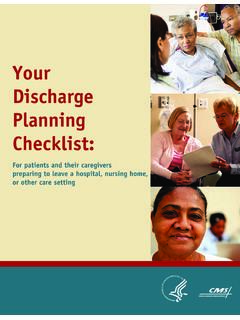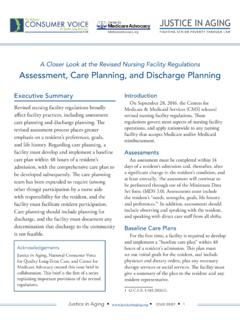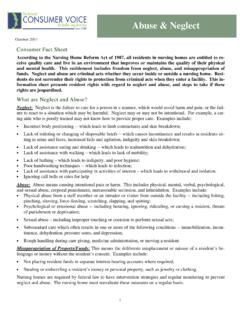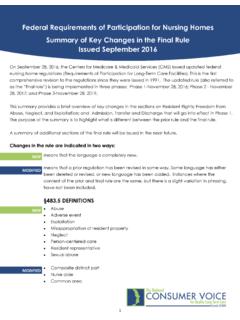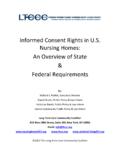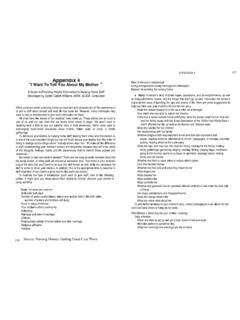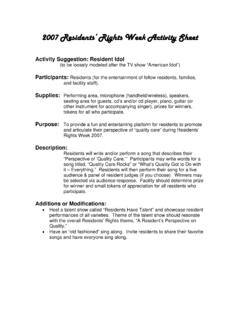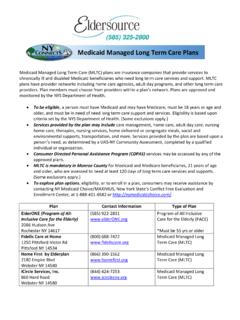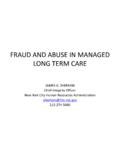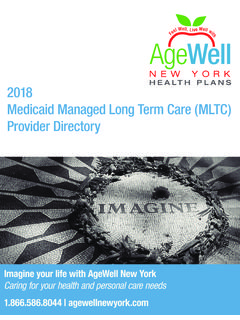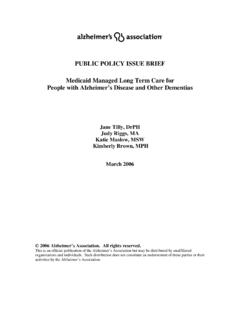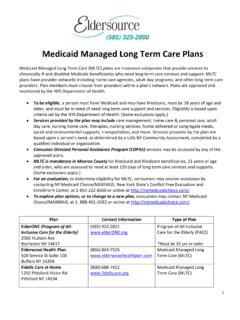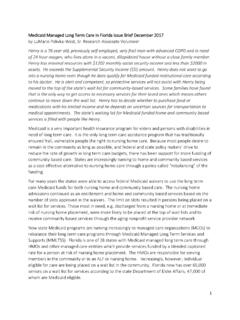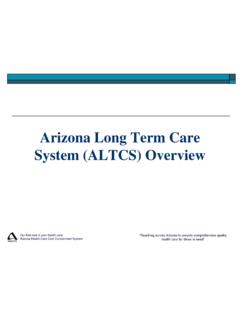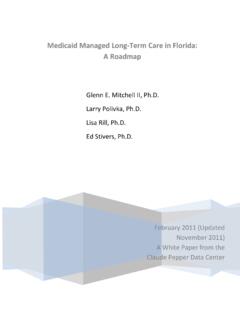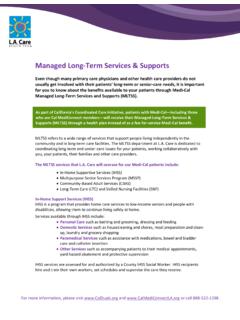Transcription of Chapter 5 Medicaid Managed Long-Term Care
1 Medicaid INSTITUTE AT UNITED HOSPITALFUNDC hapter 5 Medicaid ManagedLong-Term CareAn Overview of Medicaid Long-Term care Programs in New YorkPREPARED BY Alene Hokenstad and Meghan Shineman of the United Hospital Fund and Roger Auerbach of Auerbach Consulting, 2009 Table of ContentsProgram Snapshot3 Enrollment and Spending3 Program and Provider Capacity4 Health Status and Demographics6 Rules, Regulations, and Administrative Structure8 Federal Coverage Requirements8 Covered Services8 Service Utilization9 Eligibility Medical and Financial10 Access11 Provider Requirements12 Payment12 Quality Monitoring13 Policy Implications14 System Simplification14 Effective care Management15 Integration of Medicare and Medicaid Financing 15 Risk-Adjusted Reimbursement17 Barriers to Access17 Direct care Worker Wages18 Program Oversight18 References19 Index of Figures Figure MMLTC Enrollment and Spending 3 Figure Share of Enrollment and Spending in New York City, by Program 4 Figure Share of MMLTC Plans and Enrollment in New York City 5 Figure Managed LTC Enrollees with Cognitive Impairment 8 Figure MMLTC Spending.
2 By Type of Service 10 Index of TablesTable Average Caseload of MMLTC Plans and LTHHCP Providers 5 Table Chronic Medical Conditions Among Managed LTC Enrollees7 Table Managed LTC Enrollees Requiring Help with Activities of Daily Living 7 Table MMLTC: Covered Services 9 Table MMLTC Plan Payment Rates 13 Program Snapshot 1 This program portrait is a Chapter in An Overview of Medicaid Long-Term care Programs in New Yorkby Alene Hokenstad and Meghan Shineman ofthe United Hospital Fund with Roger Auerbach of Auerbach Consulting, Inc. PLEASE NOTE: The spending and enrollment figures in this report are estimates for 10 programs primarily serving frail seniors and adults with disabilities, including nursing homes, Medicaid Assisted Living Program (ALP),traditional personal care (PC), certified home health care (CHHA), consumer-directed PC (CDPAP), adult day health care (ADHC), the Long-Term HomeHealth care Program (LTHHCP), the Traumatic Brain Injury (TBI) waiver program, Medicaid Managed Long-Term care (MMLTC), and the Program of All-Inclusive care for the Elderly (PACE).
3 They do not include programs that primarily serve people intellectual disabilities (OMRDD) or medically fragilechildren, such as the care at Home Program. See Technical Notes for a discussion of data sources and research methods. 2 The state s Managed Long-Term care Integration and Finance Act ( Chapter 659 of the Laws of 1997) consolidates all Managed Long-Term care demonstrations and plans (including Medicaid Managed Long-Term care and PACE) under one legislative authority. 0%20%40%60%80%100 %59%8%33%41%6%53%Enrollment(n=247,000 ben efi ciaries)Spending(n=$ bi llion)MMLTCO thercommunit y-basedservicesRes idential ServicesFigure of MMLTC Enrollment and Spending as a Share of All Medicaid Long-Term care Programs, 2007 Medicaid Managed Long-Term care 3In September 2007, there were approximately 20,000 New Yorkers with nursing home levelof care needs enrolled in the state s Medicaid Managed Long-Term care (MMLTC) program, sometimes referred to as the Medicaid -only Managed Long-Term care pro-gram to distinguish it from the Program of All-Inclusive care for the Elderly (PACE), wasestablished in 1997 under the state s existing authority to provide Medicaid Managed : UHF analysis of September 2007 MARS data and FFY 2007.
4 Other community-based services include traditional PC, CHHA, CDPAP, ADHC, TBI, LTHHCP, and PACE and SpendingMMLTC program beneficiaries (enrollees) account for an estimated 8 percent of all Medicaidlong-term care beneficiaries. Medicaid spent roughly $700 million on the MMLTC program in FFY 2007, approximately6 percent of all Medicaid Long-Term care spending in programs primarily serving frail seniors and adults with disabilities in the Managed Long-Term care 40%44%56%62%38%76%24%92%8%53%47%74%26%83 %17%93 %7%20%40%60%80%10 0%0%20 %40 %60 %80 %100 %NHLTH HC PPCLTCE nrollmentLTCS pendingMMLTCNHLTH HC PPCMMLTCRes t of StateNewYorkCityFigure of Enrollment and Spending in New York City, by Medicaid LTC Program, FFY 2007 Sources: For nursing homes, LTHHCP, and traditional personal care program: UHF analysis of Medicaid reference statistics, FFY 2005-2007 (SDOH,Office of Health Insurance Programs, June 2008).
5 For MMLTC: UHF analysis of September 2007 SDOH Managed care enrollment data and SDOH Medicaid Managed care Operating Report (MCOR) data, 12/31/07, provided by the MLTC/PACE area includes New York City, long Island (Nassau and Suffolk counties), and New Rochelle regions (Westchester, Orange, and Rocklandcounties).4 MMLTC is available in at least 13 counties (Erie, Herkimer, Nassau, Oneida, Orange, Rockland, Suffolk, Westchester, and the five counties in New YorkCity). Plans may expand into additional counties. New York City vs. Rest of State:The vast majority of the state s MMLTC enrollment (92 percent) and spending (93 percent) is in New York City. This regional distribution of spending and enrollment is consistent with the pattern seen in other community-based programs, though the concentration in New York City is more pronounced.
6 It differs fromthe enrollment pattern for New York s nursing homes, in which a larger proportion ofenrollment is outside of New York City. Program and Provider CapacityThere are 13 MMLTC plans in New York (September 2007). Seven of the plans operateexclusively in New York City; one operates primarily in the city but has a small number ofenrollees in an adjacent county; and five operate exclusively outside of the city. Only threecounties outside of the New York City metropolitan area have an MMLTC , 40%44%56%62%38%76%24%92%8%53%47%74%26%83 %17%93%7%20%40%60%80%10 0%0%20%40%60%80%100%NHLTH HCPPCLTCE nrollmentLTCS pendingMMLTCNHLTHH CPPCMMLTCR estof Stat eNew YorkCit yMEDICAID Managed Long-Term care 50%20%40%60%80%100%5 plans1 pl an7 plans8%2%89%Pl ansEnrollm ent (n=2 0,00 0)No NYCenrollmentMostly NYCenrollmentOnlyNYCenrollmentFigure of MMLTC Plans and Enrollment in New York City, September 2007 Source: September 2007 Medicaid Managed care statistics, : Percentages are rounded and may not sum to 100%.
7 5 The state s Managed Long-Term care Integration and Financing Act of 1997 authorized up to 37 Managed Long-Term care plans (including MMLTC andPACE plans) for up to 25,000 frail seniors and adults with physical disabilities. Program Size:There is no limit on the number of beneficiaries that an individual MMLTC plan can seven plans with enrollment primarily in New York City are significantly larger than the five plans that operate exclusively outside the city (averageenrollment of 2,340 and 310, respectively). This pattern is consistent with the long -TermHome Health care Program (LTHHCP), which has smaller programs outside of New YorkCity. Within the City, however, average program enrollment in MMLTC plans is much largerthan in LTHHCP providers. Table Average Caseload Size of MMLTC Plans and LTHHCP ProvidersMMLTC PlansLTHHCP ProvidersNew York City2,340 (7 plans)350 (29 providers)Both NYC and ROS420 (1 plan)700 (11 providers)Rest of State310 (5 plans)100 (69 providers)Sources: Sept 2007 Medicaid Managed care statistics (SDOH) and 2007 LTHHCP and local estimates of the turnover rates for direct care workers in the home care industry range from 40 to 50 percent (Seavey et al.)
8 2006).PHI reports that in New York City, the turnover rate of the MMLTC program is higher than that of the personal care program, which is estimated to be11 to 15 percent annually. It reports that in the rest of the state, the turnover rate is comparable to or worse than the national average [Carol Rodat,PHI, personal communication, September 25, 2008]. The contrast to New York City is likely related to labor-management agreements which are standardized and approximately $2 to $3 more per hour than the wages paid by the licensed home care services programs with whom the MMLTC plans in this section of the report come from the New York State Department of Health Managed Long-Term care Final Report (2006), which citesDecember 31, 2005 data. PACE accounted for 16 percent of total MLTC enrollment in December 2005. Medicaid Managed Long-Term care 6 Program Growth:For the last five years, statewide program enrollment has grown byapproximately 20 percent per year (New York State Department of Health 2006).
9 However,plans in New York City have grown more rapidly than those in other parts of the state. Forexample, between September 2003 and September 2007, enrollment in New York Cityincreased by 135 percent, compared to an increase of only 60 percent in the rest of the :MMLTC plans typically employ nurses and social workers directly. In New YorkCity, plans subcontract with licensed home care service agencies for direct care services(home health aides and personal care aides), but in the rest of the state it is more commonfor plans to employ their own workers. There is no independent, reliable source of dataabout turnover rates at the national, state, or local Status and DemographicsThe figures in this section of the report include enrollees from both the MMLTC and in both programs is limited to individuals with nursing home levelof care needs.
10 The vast majority of enrollees receive services in community-based , a small percentage (an average of 7 percent statewide) are nursing home majority of enrollees are frail seniors. Eleven percent are adults (under the age of 65)with physical disabilities; most of these are enrolled in a single plan in New York percent of enrollees are female, 62 percent are people of color, and 43 percentspeak a primary language other than English. 8 According to the Semi-Annual Assessment of Members (SAAM), transferring is the ability to move from bed to chair, on and off toilet or commode,into and out of tub or shower, and ability to turn and position self in bed if member is bedfast. See Eligibility section for a description of the Managed Long-Term care 7 Table of Chronic Medical Conditions Among Managed Long-Term care Enrollees,December 2005 Medical ConditionPercent of TotalHypertension82%Cardiac, Heart Problems52%Visual Impairments44%Osteoarthritis42%Diabetes4 0%Stroke/CVA23%Source: New York State Department of Health (28 March 2006).

